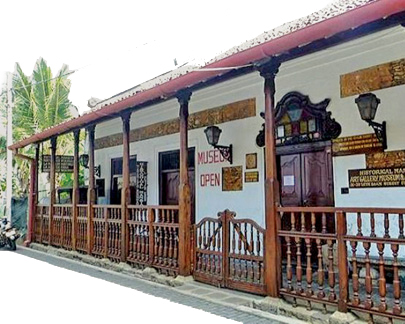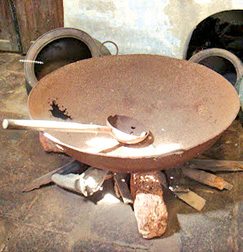 A mansion where history and culture meet A mansion where history and culture meet
By Carol Aloysius
It is a meeting place of history and antiquity. A museum which
showcases artefacts dating from pre-Portuguese era through the dutch
period to British colonial rule and beyond.
Galle’s Historical Mansion at number 31-39 Leyn Baan street lies as
the name indicates in the heart of the old Dutch Fort in Galle
surrounded by the old ramparts that protected the Dutch from invaders.
This quasi museum is the private collection of a jeweller whose hobby
was collecting anything he could lay his hands on which were reminders
of a period when Galle was a prime destination for travellers from
across the seas. Travellers who came in search of treasures to our
treasure land and went away with their ships laden with spices and gems.
The private collection of more than 1,000 artefacts belong to Al-haj
Abdul Gaffar Senior whose jewellery shop is one of over 100 such shops
within the Fort. Collected over five decades, it was a labour of love,
nothing more, nothing less for the old gent who restored it to its
current condition at great expense to himself.
“When restoring it he adhered to the old Dutch architectural pattern
using the same old Dutch clay and coral mixtured used in the
construction of the walls which are 24 inches thick.
 The building itself is 35 feet high and the woodwork is according to
both Portuguese and Dutch designs. Now in his 80th year who has handed
over the running of his business to one of his seven sons, Abdul Gaffar
Kamal Hussein., after his recent illness. The building itself is 35 feet high and the woodwork is according to
both Portuguese and Dutch designs. Now in his 80th year who has handed
over the running of his business to one of his seven sons, Abdul Gaffar
Kamal Hussein., after his recent illness.
“Everything you see here are rare items we have purchased from all
over the country. Most of them you will also see for yourself represent
some part of the history and culture of this ancient town of Galle,
where my father, his father and now we his sons continue to live with
our families”, Kamal tells me as I walked into his museum one damp
Saturday just before Christmas with my sons and grandchildren.
A pleasant chubby faced man he excuses himself from his clients who
have come there with more antique items to sell, to give us a quick
interview before we are escorted by an elderly gent who says he is one
of several retired residents of the Fort who have volunteered their
services free to show the culture of this town where they have grown up
from childhood.
“The building was crumbling when my father bought it in 1985. It
became the Historical Mansion after it was declared open by the former
President R. Premadasa”, says Kamal.
He shows us several albums of old photos of visitors to the building
which his family are justly proud of photos of Queen Elizabeth 11 and of
previous presidents of Sri Lanka. His guest book is full of comments
that praise the museum as “one of the best and most interesting places
to visit in Galle”.
Donation
“Our museum is now listed under the Archaeological Department”, he
says.
At the entrance we read “No entrance fee is charged. If you wish you
can make a donation. No tips please! The tour is free and you can take
any amount of photos free”.
 “This is my father’s dream”, Kamal explains. He has put together
these antiques for the public to see and enjoy without feeling any
pressure on them to buy tickets or even purchase any item. His greatest
pleasure is to see visitors dropping in at all times of the day to
browse through his collections”. “This is my father’s dream”, Kamal explains. He has put together
these antiques for the public to see and enjoy without feeling any
pressure on them to buy tickets or even purchase any item. His greatest
pleasure is to see visitors dropping in at all times of the day to
browse through his collections”.
Archaeologists believe the building to be the oldest within the Galle
Dutch Fort.
It is also the largest private museum in Galle, housing not just the
museum, but a shopping arcade selling and handicrafts and stationery and
of course exquisite jewellery including ancient filigree chains, pethi
malas, earrings and even snuff boxes and elaborate combs worn by the
Portuguese and Dutch ladies.
It is easy to see everything the Museum offers if you follow the
specific path which your tour guide will tell you ahead. At the centre
of the room is an ancient steel anchor from a ship wreck recently
discovered whose hoary appearance (it is now fully coated with sea
corals stuck firmly onto it) puts its probably age to around 200 years.
Then you enter a room filled with old paper notes and coins, an old
juke box and old gramophone with records dating to the Elvis Presley
era, and a display of ceramic ware including dainty tea cups and kettles
used during the Dutch period.
Next you spill out into an open courtyard flanked by high white
columns and high roof, where a woman shows you how beeralu lace (used
popularly by the Dutch ladies) was made as a cottage industry, her hands
expertly weaving fine embroidery on raw cotton, while an elderly man
demonstrates to you with pride his skill in cutting and polishing gems
harking back to age old methods when there were no advanced machines to
do this work.
Courtyard
 The piece de resistance, however, lies in the open courtyard where an
ancient Dutch well still using ropes on iron hooks to draw fresh water
that we are told comes from an underground spring. The water is sweet
but we don’t take more than a sip although Kamal assures us it is pure! The piece de resistance, however, lies in the open courtyard where an
ancient Dutch well still using ropes on iron hooks to draw fresh water
that we are told comes from an underground spring. The water is sweet
but we don’t take more than a sip although Kamal assures us it is pure!
At the side of the well, standing upright is a stone slab sculpted in
1763. “It is the original VOC slab and the oldest artefact in this
building”, says Kamal pointing to the Dutch inscription. “We discovered
it while excavating the well”.
The last place we are taken to is the Old Kitchen which still
contains the old miris gala (grinding stone), clay pots and pans and old
fireplace. “It is the exact replica of an old Dutch kitchen.
Even the coconut scraper and the hooks on which the pots are hung are
a true replica of the ancient Dutch kitchens”, he says, in keeping with
our main theme of preserving the different cultures that have made their
impact on this town”. Yes indeed.
This historic mansion is no doubt a vibrant landmark in a historic
town that once bustled with life and activity. A town where fashionable
Dutch ladies daintily made their way over cobbled pavements which are
still preserved, for their evening walk, and where housewives haggled
with fishmongers and vegetable vendors and grocery owners at peddlars
street.
Expensive
 With the burgeoning tourist industry, on these ancient streets has
now sprung expensive cafes and restaurants that serve original Dutch
food if you ask for it. Where you can sip your Ceylon tea in dainty tea
cups fashioned during Dutch times and wipe your mouth on a elegantly
folded napkin afterwards. With the burgeoning tourist industry, on these ancient streets has
now sprung expensive cafes and restaurants that serve original Dutch
food if you ask for it. Where you can sip your Ceylon tea in dainty tea
cups fashioned during Dutch times and wipe your mouth on a elegantly
folded napkin afterwards.
Your dessert is an assortment of Dutch sweets
whose taste will linger in your mouth long after you have left the Fort.
Before we leave we meet the grand old man Al Haj M.H.A. Gaffar, the
founder the historic mansion who waits for us in his wheel chair. “I’m
so glad you were able to come. Bring your friends and spread the word
that we have a treasure trove awaiting them in this Fort” he says, as we
wave goodbye.
|

